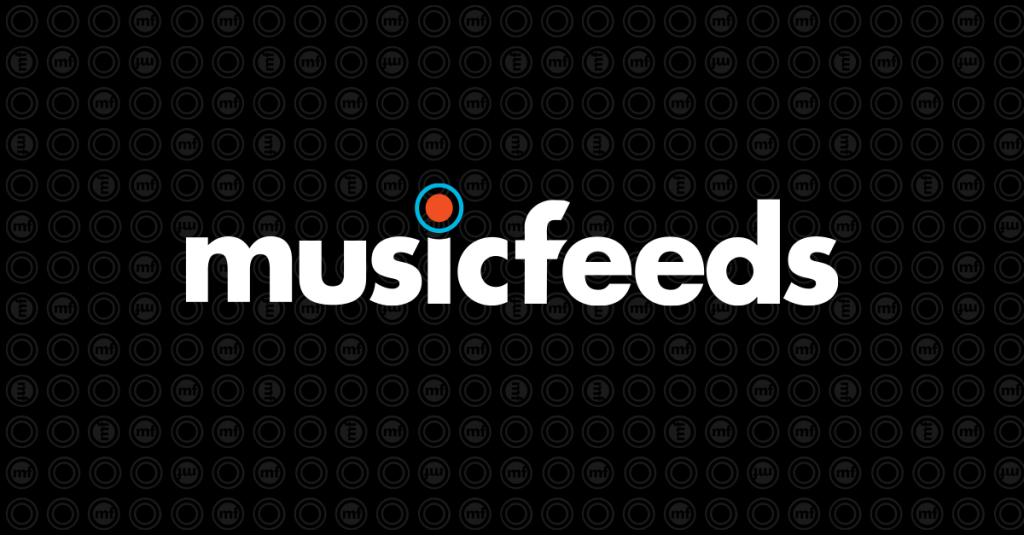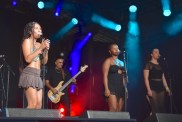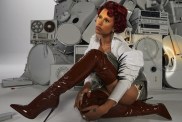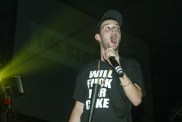What do Keanu Reeves, car transistor radios and a chair covered in bottle caps have in common? Seemingly nothing. Yet, somehow artists Oscar Ferreiro, Adam Cruickshank and Tim Hillier have managed to gather these disparate themes in a show at Melbourne’s West Space. Such obscure contemporary art shows are often weighed down with dense theoretical essays to the detriment of the work. Happily these works manage to balance art theory with the pleasure principle, as well as large doses of humour.
Ferreiro’s installation “Present Tense” consists of thirty dismantled transistor radios from $2 dollar stores, draped all over the first room of the gallery in a multi coloured tangle of cheap rubber and tin. The radios have been disembowelled from their plastic shells, strewn against the wall and hang in clusters from the ceiling. A button in the middle of the floor tempts the ball of your foot and when hit, triggers a cacophony of white noise, static, and possibly the strangled sounds of a Spanish guitar lost in the airwaves somewhere. Ferreiro warns a side affect of the work may be an unruly headache. More importantly he explains the work as the tension between experiencing phenomena “in a linear sequential fashion” or “simultaneously, where time and space subside.” But perhaps the work’s strength also derives from the sheer enjoyment of tearing apart thirty radios and unleashing the blurred remains of their airwaves in a formal gallery space.
Any attempt to move to the next room of the gallery is immediately thwarted by Cruickshank’s barbed wire obstacle, resembling something straight out of the Somme battlefield. Yet the barrier has become oddly domesticated, the wire entrapping a set of dining room table legs. Finding a way into the room from another entrance, the full scale of “Domestic Death Rattle” is revealed to be a motley assortment of objects and collages. Cruickshank sets out to critique Australia’s obsession with bettering our homes and gardens with banal home furnishings, ubiquitous in stores like Ikea, Bunnings and Freedom. “Ikea Lagerphone” is the strongest piece, consisting of a chair covered in beer bottle caps, nails and key rings- a bric-a-brac homemade answer to mass produced, soulless furniture. Alongside the chair is the playful addition of a bottle -capped broomstick. Ironically shoved inside a designer shoe the piece longs for some street busker to shake it or stamp it into the pavement for musical effect.
Cruickshank also addresses the historical anachronisms of design by upturning familiar objects like ornate ceiling rose fittings on the floor and moulding them out of cheap plastic. Such decorative furnishings had a purpose in the Victorian era as part of gas light fittings but now represent the quintessentially genteel addition to any living room ceiling. While Cruickshank’s themes are strong the execution of the space lacked a coherent feel, perhaps a deliberate ploy to underscore the twee neatness of contemporary furnishings, however the accompanying collages did not stand up against the sculptural pieces.
Lastly Hillier’s video “Point Break (aka Give Me Convenience, Or Give Me Death)”, is a playful composite of Keanu Reeves’ keynote films in Point Break (1991) and Bill and Ted’s Excellent Adventure (1989). One screen shows Reeve’s Johnny Utah wimping out from shooting Patrick Swayze’s Bodhi as he flees in a rubber Ronald Reagan Mask. Utah screams with futility and fires into the air in frustration at his inaction. The second screen shows Reeve’s Ted falling endlessly, not knowing when to stop screaming. Hillier suggests in his synopsis that the work offers you the thought “If you had the chance to kill one of the world’s leaders, would you?” Perhaps this can be gleaned from the Point Break Scene, but it seems a long bow to stretch, to link that thought to the scene from Bill and Ted’s Excellent Adventure. Or maybe my reflections on which world leader I would kill was overtaken by watching the penultimate moments of Keanu’s career placed together, wondering how he fell so far from cool to a film like “The Lake House” (2006) with Sandra Bullock.
In any case, the eclectic exhibition offered an unlikely but enjoyable assemblage. Up next at West Space is Lionel Marchetta’s “Nautra Morta” as part of the 2010 Liquid Architecture Festival.
West Space
1/15 Anthony St, Melbourne VIC 3000
June exhibition: Oscar Ferreiro, Adam Cruickshank and Tim Hillier
West Space is a non-profit artist-led organisation supporting the activities of artists within a critical context. See the current program here.
Image by Kelly Fliedner










